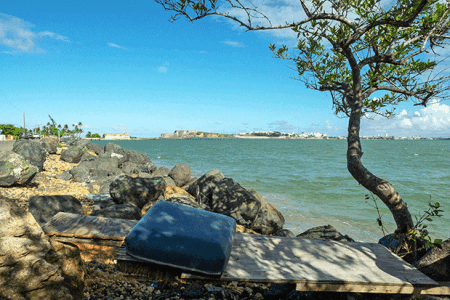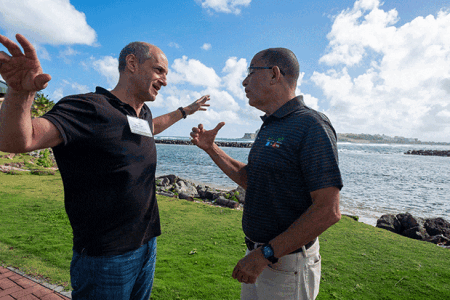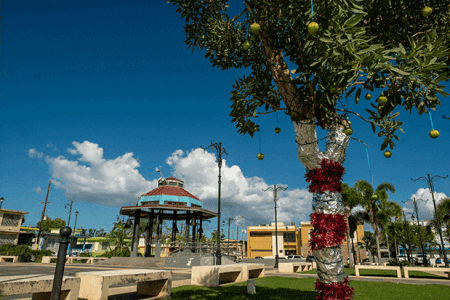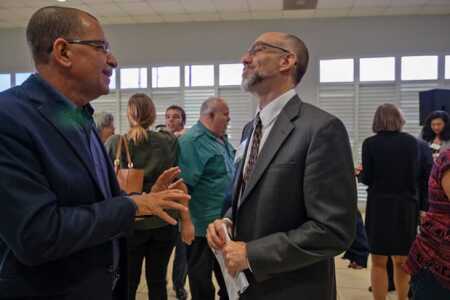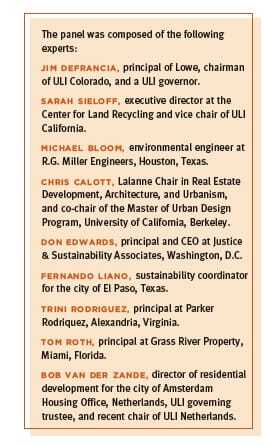In September 2017, Hurricane Maria—the deadliest storm to hit Puerto Rico in 100 years—slammed into the island’s coast with winds that reached 155 miles per hour (250 kmph). This occurred just a few short weeks after Hurricane Irma had already hit the island with devastating effects.
Hurricane Maria left all 3.2 million residents on the island without electricity, and most without water and communications. “The whole island was affected in ways that nowadays is difficult to comprehend—no power, no banking, no communications, no food, no access, no diesel. . . . It was as if you went to sleep one night in 2017 and woke up back in time in the late 19th century,” says architect Ricardo Alvarez-Diaz, the local district council chair and a ULI governor. “The physical damage is devastating, but the over 3,000 people that lost their lives is unbearable.”
These storms rounded out a particularly hyperactive and catastrophic 2017 hurricane season, affecting Florida and Texas in addition to the commonwealth of Puerto Rico and registering as one of the costliest tropical hurricane seasons on record.
In addition to being physically vulnerable to hurricanes and other major acts of nature, Puerto Rico is in economic decline and in a long-term recession that began in 2006. Furthermore, the commonwealth government has about $70 billion in outstanding debt and entered Chapter 3 bankruptcy proceedings in spring 2017.
To contribute to the commonwealth’s recovery effort, ULI’s Advisory Services program engaged with ULI Southeast Florida/Caribbean and the Puerto Rico Builders Association to select a municipality to receive technical assistance focusing on enhancing resilience and strengthening the economy, as well as to act as a model for the implementation of best practices. The panel was a philanthropic effort, funded by the Kresge Foundation and ULI Southeast Florida/Caribbean, and supported by Alvarez-Diaz & Villalon Architecture and Interior Design. The partnership among Alvarez-Diaz’s firm, the Puerto Rico Builders Association, and ULI selected Toa Baja, a municipality of more than 80,000 residents located just west of Puerto Rico’s capital city, San Juan, to be the focus of the panel.
Toa Baja
Toa Baja shares the island’s overall vulnerability to climate risks and economic conditions. The municipality’s economy suffered greatly from Hurricane Maria, particularly with loss of economic activity and more than $1.3 million in damage to its infrastructure, including over $400 million in damage to personal residences and other assets. Alvarez-Diaz notes that Toa Baja presented “a unique opportunity to showcase a community that represents a microcosm of the challenges within the commonwealth of Puerto Rico.”
Toa Baja, which means “lower cowshed,” is in a low-elevation area adjacent to El Rio de La Plata, the commonwealth’s longest river, which flows south to north, and borders the municipality to the west, before draining into the Atlantic Ocean. In the past three decades, the municipality has suffered from extreme flooding about once every six years because of its low coastal elevation and proximity to El Rio de La Plata. The U.S. Army Corps of Engineers is currently undertaking a major flood control project in the river basin. The Army Corps project, which was originally scoped in the 1980s, is highly anticipated by the community to catalyze flood mitigation efforts.
Toa Baja’s economy historically relied on agriculture but made the transition to manufacturing in the early 1960s. During this transition, the neighborhood of Levittown, Puerto Rico, was established as one of the largest planned communities in the commonwealth. Upon delivery, Levittown was a highly sought-after suburb community outside San Juan. Located on slightly higher ground, the community of Levittown was affected by hurricane conditions on El Rio de la Plata in 2017, experiencing unprecedented waist-high flooding.
In December 2018, Toa Baja’s leadership hosted the Advisory Services panel to deliver recommendations to enhance the community’s economic and climate resilience. “For decades, many of the key planning issues in our community were either ignored or not dealt with,” says Mayor Bernardo “Betito” Márquez, who for years was a local private sector and community leader. “It was clear that doing things in a traditional way would be ineffective. I felt that the combination of local community leadership working together with experts from ULI from around the globe would be the best way to disrupt the process and rethink all these issues.”
As severe weather events become more frequent and intense due to climate change, resilience has become an increasingly important issue for communities like Toa Baja, as well as for all people involved in making decisions about the built environment, including real estate developers, designers, planners, elected officials, and others. Through Advisory Services, ULI engages expert members across the real estate and development fields to offer pragmatic, unbiased, and nonpartisan solutions to complex urban development problems.
The international group of panelists was charged with providing recommendations on ways to improve preparedness for extreme weather events and to provide a roadmap to long-term resilience, focusing on economic development, housing, and land use strategies. The panel’s expertise included the following: real etate development and design, community mediation, environmental engineering, landscape design, and land recycling.
During the panel’s week in Puerto Rico, panelists toured the study area and engaged with residents and other stakeholders from the public and private sectors, including Toa Baja municipal leadership and Mayor Márquez. Panelist Trini Rodriguez notes that “meeting with residents really opened our eyes to the human impact and emotional toll of these natural events. Community members openly expressed their feelings and many cried as they relived the experience. But despite the hardship, they all wanted to be an integral part of a more resilient rebuilding strategy. Our proposal includes recommendations garnering this social capital as part of the rebuilding action plan.”
Following the week of briefings, site tours, and community stakeholder interviews, the panel delivered strategic recommendations to enhance the social, physical, and economic resilience of Toa Baja.
The panel laid out strategies to strengthen economic development initiatives, including immediately actionable methods to potentially secure Community Development Block Grant Disaster Recovery (CDBG-DR) funds from the U.S. Department of Housing and Urban Development. They recommended that Toa Baja work to position itself to receive funds by prioritizing ready-to-go projects and establishing strategic partnerships among the community and the local and federal governments. Through these partnerships, the municipality will be able to build credibility to position itself to receive earmarked funds available to address redevelopment and disaster recovery. By demonstrating a readiness to deliver projects through thoughtful and methodological approaches, Toa Baja can kick-start an effective strategy for redevelopment.
The panel also proposed targeting development zones that are at higher elevations and suggested incentives to encourage the delivery of mixed-use projects in those areas. The municipality of Toa Baja should prepare short-, medium-, and long-term plans that will create opportunities to support catalytic development projects located in those zones. Supporting those developments can help Toa Baja respond to its critical housing demand while positioning the municipality for sustainable economic growth.
Toa Baja is extremely vulnerable to climate-related risks, including those from sea-level rise, hurricanes, and earthquakes. Physical infrastructure throughout the municipality was damaged during the recent hurricane season and from other events. A major focus of the panel was proposing strategies for how to restore physical assets to be better than they were before those storms.
Channelization of El Rio de la Plata, originally proposed over 20 years ago by the Army Corps of Engineers, was devised as a project with a single purpose—flood reduction—using gray infrastructure such as pipes, pumps, ditches, and detention ponds. Although the allotment of funds has been approved by Congress for the Army Corps to undertake a major flood control project along the river basin, it has not yet been implemented. The panel took this opportunity to reimagine the project with nature-based design systems and recreational opportunities to create a public amenity while still reducing the flood risk for surrounding areas.
Panelists also recommended strengthening current and new real estate development and infrastructure by prioritizing code compliance, and investing in and strengthening the electricity infrastructure. The panel identified funds available to strengthen Toa Baja’s code enforcement, which would include the training of new inspectors, partnerships with community organizations, promotion of cross-agency coordination, and implementation of a penalty for noncompliance. Having reliable structures and systems would support further development and potentially attract new economic opportunities to the area.
A strong community fabric makes for a resilient community. The panel recognized that communication, community engagement, and consensus building are key building blocks to achieving a strong and resilient civic infrastructure. Panelists recommended that municipal leaders focus on preparing and enabling residents to rebuild and recover as a community, by creating programs that help residents understand their role in recovery and personally prepare for future events. For example, the municipality can provide programs that offer support for filling out recovery aid applications and suggest ways for residents to prepare their families and homes for future emergencies. A strong civic infrastructure will encourage locals to collectively prepare themselves and bounce back in a way unique to their community.
Panelists also recommended designating a municipal resilience liaison to advocate for on-the-ground community needs and bridge communication between the community and various levels of government. The person in this role would enhance organizational alignment by prioritizing and advocating for residents, supporting public/private partnerships, and identifying sources of funding.
“We need to do whatever we can to make sure that when a situation like this happens again, we can be educated and prepared,” says Mayor Márquez. “We owe it to all the people that lost family members and loved ones during the storm.”
The panelists believe that as a microcosm of economic and resilience challenges faced at the commonwealth level, Toa Baja can implement social, physical, and economic strategies that may be replicable in towns across Puerto Rico to enhance overall resilience.
A vibrant vision for Toa Baja’s future already exists; panelists heard about it from residents, political leaders, and business owners alike, said Sarah Sieloff, the panel’s vice chair and the executive director of the Center for Creative Land Recycling. “The panel took this preexisting vision and paired it with the reality that storms will come again,” she says. “Ultimately, our recommendations are grounded in an understanding of Toa Baja’s vulnerabilities, a focus on jobs and housing, thinking critically about how and where to build, and viewing resilience in a business sense, especially considering the costs of inaction.”
Panel chairman and ULI Life Trustee James DeFrancia, president of community development at Lowe Enterprises in Denver, says, “We are excited to have brought the expertise of our members to Toa Baja. The strength of the Advisory Services program lies in ULI’s unique ability to draw on the substantial knowledge of members representing all aspects of the real estate industry. The independent views of the panelists bring a fresh perspective to challenges such as this one. The Advisory Services program is all about offering creative, innovative approaches to community building.”
ULI members can find this report and more than 500 others on Knowledge Finder.

